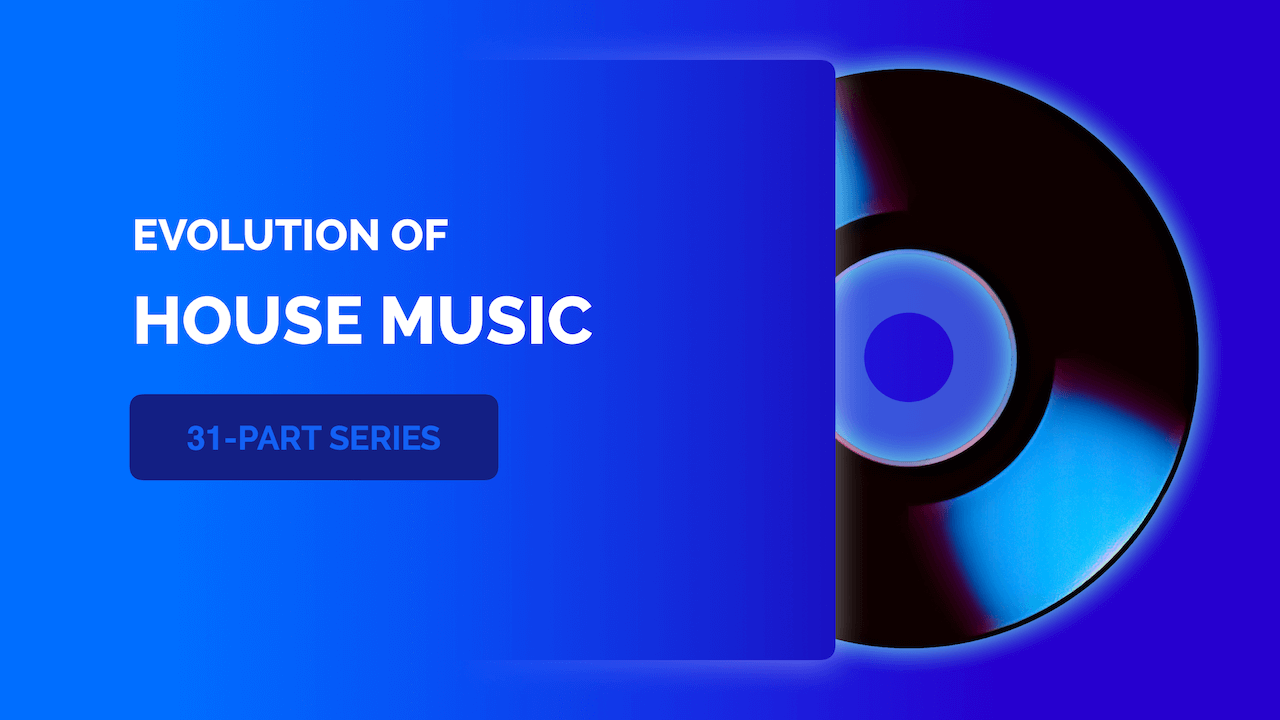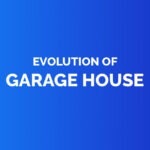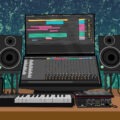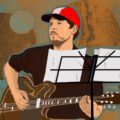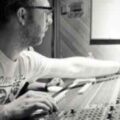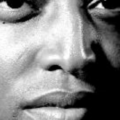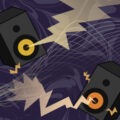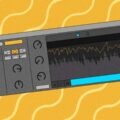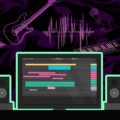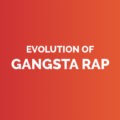This series celebrates house music’s 40th anniversary by offering a glimpse into its early roots and chronicling its rapid growth; from the ashes of disco, to the dominant family of genres it has since become.
The rise and fall of disco in popular music left clubs with a shrinking supply of new dance music at the end of the 1970s. The lack of new disco hits meant DJs had to recycle old disco, soul, and R&B tunes in an attempt to keep the club experience fresh. With the help of a handful of pioneering DJs and producers, a cultural and musical phenomenon called house music began to develop in the clubs and radio stations of New York and Chicago.
Garage House
New York, 1980
The earliest form of house music started in two clubs: Paradise Garage in New York and Club Zanzibar in New Jersey. Garage house music is deeply rooted in R&B and soul and can sometimes be indistinguishable from disco.
Learn more about the evolution of garage house ▸
Chicago House
Chicago, 1985
Chicago house started with DJ Frankie Knuckles at The Warehouse and Ron Hardy at the Music Box. Both would go on to be known as highly influential players in house music, with Knuckles often called the Godfather of House.
Learn more about the evolution of Chicago house ▸
Deep House
Chicago, 1985
Early deep house music began in the mid-1980s with a simplistic and quantized (robotic) feel. Producers like Larry Heard (Mr Fingers) and Marshall Jefferson, who are considered deep house pioneers, gave the genre its human touch by infusing jazz elements with deep bass lines.
Learn more about the evolution of deep house ▸
Latin House
Chicago, 1985
From the beginning, house music drew from a massive set of musical influences. One of the earliest examples of this appeared in Chicago with DJs of Latin American descent incorporating Latin rhythms and Spanish vocals in their house mixes.
Learn more about the evolution of Latin house ▸
Acid House
Chicago, 1986
From what started as an experiment by programming the Roland TB-303 Bass module to perform drum patterns by DJ Pierre and his group Phuture, the genre of acid house quickly developed. The acid house scene peaked in Chicago between 1987 and 1988, started to dwindle, and then pick back up and become further evolved across the pond in Manchester, London.
Learn more about the evolution of acid house ▸
Hip House
London, 1987
Hip house came from the catchy marriage of euro house music with American hip hop vocals. As the genre developed, two styles emerged: in the US, hip house was slower, more grounded in its hip hop roots; in Europe, hip house was faster, more grounded in its house roots.
Learn more about the evolution of hip house ▸
Eurodance
Italy, 1989
Eurodance is a melting pot of catchy vocal hooks, rap sections, synth riffs, samples and a hard hitting four-on-the-floor beat. Traces of earlier house styles like Chicago and acid house as well as techno can all be found in eurodance music.
Learn more about the evolution of eurodance ▸
Progressive House
London, 1990
Progressive house is directly influenced by the rave and dance scenes of the US, UK and Europe. Early on, progressive house was indistinguishable from trance but, by the early 90s, its aesthetic elements could be traced back to everything from Euro house to Chicago house.
Learn more about the evolution of progressive house ▸
Ambient House
London, 1990
Ambient house came to prominence as an antidote to rave music with its slowed-down, mellow vibe. The genre is now omnipresent and by some metrics encompasses new age, ambient trance/techno, space rock and contemporary instrumental.
Learn more about the evolution of ambient house ▸
French & Funky House
Paris, 1992
First popularized by Daft Punk, French and funky house is about keeping classic funk and disco at the forefront of dance music. Many genres of house music incorporate funk and disco, but none have created a blend of classic and innovative sounds as refreshing as French and funky house.
Learn more about the evolution of French & funky house ▸
Diva House & Nu-Disco
London, 1992
Diva house was a short-lived but highly popular disco revival in the 90s. It spawned from renewed interest in disco among the gay British community would and quickly become a global club sensation. Influenced by eurodance and Italian disco, diva house turned out to be nothing more than a fad that disappeared as quickly as it emerged. The genre died out in the late nineties; however, it resurfaced as nu-disco shortly after and has been going strong ever since.
Learn more about the evolution of diva house & nu-disco ▸
Ibiza House
Ibiza, 1993
While Ibiza house is influenced by the rhythm and continuous bass of trance, it’s arguably more influenced by its surroundings. Spanish guitars and mandolins from the local music scene are often infused with acoustic percussion and ambient sounds of birds and ocean swells.
Learn more about the evolution of Ibiza house ▸
Microhouse
Germany, 1993
Microhouse, also known as minimal house, consists of bit-sounding rhythmic elements, techno-style synths, electric pianos, pads, and industrial sounds. As the name suggests, microhouse thrives in minimalism, where swells of sound exist to emphasize the silence that ensues.
Learn more about the evolution of microhouse ▸
Tribal House
New York, 1993
DJs from New York clubs like Sound Factory and Roxy NYC borrowed polyrhythmic percussion from old crates of world music to establish tribal house. By the early 90s, artists like Danny Tenaglia and Junior Vasquez were releasing globally popular tribal house music.
Learn more about the evolution of tribal house ▸
Kwaito
Johannesburg, 1994
Kwaito is both a celebration of freedom and a peek into South African ghetto life. Sonically, kwaito is inspired by Mbaqanga, a 1960s South African genre with rural Zulu roots. Early kwaito artists fused the sounds of Mbaqanga with hip hop and house to create the distinct sound of kwaito.
Learn more about the evolution of kwaito ▸
UK Hard House
London, 1994
UK hard house took the driving disco beat from eurodance, removed a lot of the whimsical and emotional elements like epic never-ending climaxes, and added simple elements like short drops with no drums, hard bass stabs and quirky samples.
Learn more about the evolution of UK hardhouse ▸
Electro Swing
Copenhagen, 1994
Electro swing is what you get when you slap hip hop or electronic dance beats on top of vintage swing music, often sampled from big band swing music of the 30s and 40s. The novelty style is responsible for a small number of commercial successes, most notably “We No Speak Americano” by Yolanda Be Cool.
Learn more about the evolution of electro swing ▸
Tech House
London, 1995
Tech house fuses synth programming from techno with house beats ranging from classic Chicago house to progressive and tribal house. It’s minimal, funky, and reminiscent of deep house with its noticeable absence of drops.
Learn more about the evolution of tech house ▸
Ghetto House
Chicago, 1997
The ghetto house prequel started in the 90s as an offshoot of Chicago house, but there was about a 15-year wait before the main act emerged in 2013 with aspects of modern techno, EDM, trap and electro house.
Learn more about the evolution of ghetto house ▸
Electro House
The popularity of a style of music at any given time can be defined by its influence on the songs being played on the airwaves and in the club. In the early 2000s, radio had been hijacked by rock music and clubs had been taken over by trance, leaving house music briefly out of favour and in desperate need of a refresh. Enter electro house: a new European fusion of electro, tech, and house music. While electro house music was being produced as far back as the 90s, it wasn’t until Benny Benassi’s 2002 smash hit “Satisfaction” that the world really started to embrace electro house and its own family of genres: fidget house, complextro, Dutch house, moombahton, Melbourne bounce, and big room. We’ll explore each genre under the electro house umbrella separately.
Fidget House (Electro House Sub-Genre)
Paris, 1999
Fidget house is defined by its glitchy samples, pitch bending synths and dubstep wobble, and quick cuts over a 4/4 beat. The arrangement in many fidget house songs is noticeably simple in order to highlight the synth-rhythm relationship.
Learn more about the evolution of fidget house ▸
Dutch House (Electro House Sub-Genre)
Amsterdam, 2002
Detroit techno became hugely popular in 90s Netherlands dance culture, and would go on to figure prominently in the Dutch house sound. Dutch house also borrows lyrical elements from hip hop as well as rhythmic elements from Latin and tribal house.
Learn more about the evolution of Dutch house ▸
Moombahton (Electro House Sub-Genre)
Washington DC, 2009
Moombahton began in 2009 when DJ Dave Nada, performing for a basement party crowd that wasn’t particularly into house music, slowed down Afrojack’s Dutch house remix of “Moombah” from 128 to 108 bpm. The crowd allegedly went nuts, and moombahton was born.
Learn more about the evolution of moombahton ▸
Complextro (Electro House Sub-Genre)
North Carolina, 2010
In the late 2000s, fidget house began to evolve into complextro. By the time the term was coined by Porter Robinson, the complextro style had already emerged in songs by artists like Skrillex and Savant.
Learn more about the evolution of complextro ▸
Melbourne Bounce (Electro House Sub-Genre)
Melbourne, 2010
Melbourne bounce is an upbeat subgenre of electro house that was popularized by Australian DJs like Will Sparks and Joel Fletcher. Many of electro house’s other subgenres feature prominently in Melbourne bounce, from complextro to Dutch house, with rhythmic inspiration coming from jumpstyle and massive bass lines from psytrance.
Learn more about the evolution of Melbourne bounce ▸
Big Room (Electro House Sub-Genre)
Stockholm, 2011
Big room is a direct descent of earlier electro house, taking inspiration from fidget house, complextro, and Dutch house. But in contrast to its earlier electro house influences, big room emphasizes minimalism, using only two or three instruments and drums that rarely feature more than a kick, tom and hi-hats.
Learn more about the evolution of big room ▸
Outsider House
London, 2010
Outsider house is mostly influenced by Chicago house, techno-noise, and downtempo. Other influences include acid house and microhouse, which popularized the use of unconventional sounds like non-musical rhythmic elements, backwards samples and experimental synths used in outsider house.
Learn more about the evolution of outsider house ▸
Gqom
Durban, 2011
The percussive vocal style of kwaito (which has its roots in Mbaqanga, a 1960s South African genre with rural Zulu roots) is freshened up with a beat that steps away from traditional house music’s four-on-the-floor rhythm. The beat reflects a more traditional African drum sound, while the lyrics take their cues from South African nightlife. Gqom is pronounced “gom” with a tongue click at the start of the word.
Learn more about the evolution of gqom ▸
Tropical House
Edinburgh, 2013
Sax solos supported by tropical instruments like marimbas, nylon guitars, pan flutes, and steel drums over simple chords and a slower rhythm give tropical house its happy, laid back sound that evokes tropical escapism. Tropical house is a highly melodic genre that uses fairly standard house rhythm patterns, with occasional exceptions made for reggaeton. White noise and beach sounds make frequent guest appearances to complete this vacation-in-your-headphones genre.
Learn more about the evolution of tropical house ▸
Future House
Paris, 2013
Vocal hooks ranging from soul to euro pop set up blistering drops with funky, often metallic synth riffs that are sometimes indistinguishable from big room. The combination of these elements with Dutch and fidget house rhythm patterns is what gives future house its distinct sound.
Learn more about the evolution of future house ▸
Bass House
London, 2015
In the early 2010s, bass-heavy ghetto house and EDM-infused future house came to prominence. Artists like Basement Jaxx and Joyryde seem to have taken inspiration from these two genres in particular to create a new, distinct style that would come to be known as bass house. The genre builds on the wonky synths and rhythm patterns of fidget house but, when it comes to bass, the most audible influence is dubstep’s wobble and growl.
Learn more about the evolution of bass house ▸
Amapiano
Pretoria, 2016
Much like gqom, amapiano is a South African style of music born from kwaito. Amapiano emerged from the townships of South Africa, particularly Pretoria, a small city just outside Johannesburg. Amapiano can best be described as the groove of deep house, the rhythmic sound of kwaito, and the addition of jazz piano and percussion often inspired by Bacardi house (itself a sub-genre of kwaito).
Learn more about the evolution of amapiano ▸
This series is intended to celebrate house music by helping you understand where it comes from and how it has developed around the world over the past four decades. While we have organized the series into a set of 31 genres, it is important to remember that each genre is nothing more than a name given to represent a common set of influences and styles. The evolution of house music is driven not by artists that paint within the lines, but by innovative music creators who take inspiration from music and culture and channel it into something new. We hope the music shared in this series will inspire you to push your own musical boundaries; whether that means finding your niche within an existing genre, or developing a new style that attracts other music creators to follow your lead.
